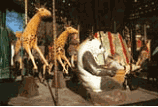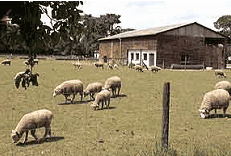Zoological gardens / farms
Animals of the world

© Paris Tourist Office -
Photographe : Catherine Balet
Within the walls of Paris, the city counts only
two zoological gardens: one in the Jardin des Plantes and one
in the Bois de Vincennes. To discover animal species from the
European forests, the jungle, the mountains, the deserts and other
far flung territories, it is necessary to travel some kilometres
outside the city.
If you have a vehicle, however, and would like to move
amongst wild animals through a glass tunnel; shiver you way through
a reptile house; admire the aerial prowess of falcons and other
birds of prey; enjoy the antics of monkeys; or dream away in a
butterfly greenhouse, then the trip could be worthwhile for you.
Georges-Ville farm (bois de vincennes)

Source:www.parisbalades.com
The Georges-Ville farm bears the name of the pharmacist-physician-chemist who, in 1860, dedicated a field in Vincennes agricultural experiments. It exists today as an educational farm: beetroots are grown there, as well as sunflowers and flax and it is home to goats, rabbits, geese, cows, pigs… Visitors can milk a cow, churn butter, shear a sheep, spin wool and generally get a taste of farm life.
Zoo de Vincennes (Métro Porte Dorée)
53 avenue de Saint-Maurice (tel. 01 44 75 24 10 or 01 43 43 84 95, open 9.00-17.30)
The Zoo de Vincennes is one of the richest in
Europe. It replaced the old zoological park created for the colonial
exposition in 1931, which was one of the most popular attractions
of the exposition, drawing 50,000 visitors on its first Sunday
– all excited to see wild animals in “freedom”.
Carl Hagenback, a German who had conceived the modern zoo in Hamburg
in 1907, was commissioned to do the same for Paris. His idea consisted
of presenting the animals in apparent liberty, separated from
visitors by trenches and concealed grills, so that the visitor
would have the impression of walking through open nature. As the
zoo was reserved for African fauna, no tigers were seen there.
The success of the zoo brought about the decision
to create a bigger park; “a theatrical decor moulded in
cement, a stylised and wild landscape, sometimes smiling, sometimes
severe and impressive.” The great rock, measuring 72m in
height, was inaugurated in 1934.
Today 550 mammals and 700 birds of over 200 different species
live in the zoo. On cold days, the animals retreat to their cages:
where they can be viewed by the public. The great rock has recently
been renovated and is once again home to goats, chamois and vultures.
It was completed with rock-slides, waterfalls and best of all;
visitors can now access the interior of the rock and climb up
to the belvedere, where it affords a fine view over Paris and
Saint-Mandé.
If you wish to know more about the animals, visit the website of the Paris Tourism Office, where you will find out where to go for an unforgettable experience meeting the animals of the world.
Make the most of your stay by visiting the museums and monuments. Not to mention around Paris, the boat trips, the bridges, the Parisian squares, the parks and gardens, the unusual spots, or the operas, where you can stroll around at your ease.
(For information
:
category
"Visits in Paris and île de France"
et "Not
to be missed").
- Paris-city Partners :
- Music News
- Rock, Jazz & Blues CDs
- Learn French in Paris
- Learn French in France
- Paris Junior Programs
- Learn English in England
- Business English Courses
- Need a translation?
- For teachers of French
- French Exercise & Tests
- Directories
- English courses for Teens in UK
- Camps for Teens in England
- Language Courses Abroad
- English courses in England
- Learn a Language Abroad


